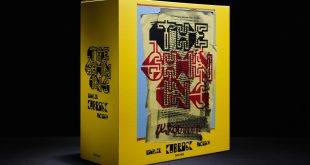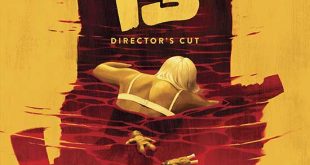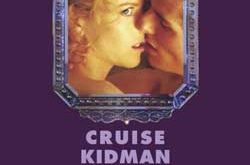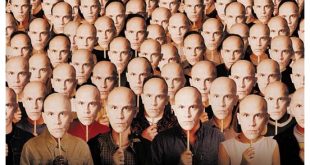 When I asked Horror News readers and Facebook friends to tell me their favourite cult films, I got a terrific response. The suggestions poured in, and all kinds of weird, wonderful and outlandish films fronted up for selection. So while I can’t deny the quality or appeal of films like Reefer Madness (1938), Citizen Kane (1941), Glen Or Glenda (1953), Attack Of The Killer Tomatoes (1978), or The Toxic Avenger (1984), I can only count it down to twenty. But what a list it is, celebrating some of the best and most original films in cinema history, from the salacious kink of Blue Velvet (1986) to the sweetness and light that is The Sound Of Music (1965). As you can imagine, in some cases such as Star Wars IV: A New Hope (1977), Mad Max (1979) and The Matrix (1999), many voters recommended entire series of films, and I wish to thank Wikipedia profusely for assisting me in my research. Read on and embrace some of the most unusual and deliciously bent films that you’ll ever see!
When I asked Horror News readers and Facebook friends to tell me their favourite cult films, I got a terrific response. The suggestions poured in, and all kinds of weird, wonderful and outlandish films fronted up for selection. So while I can’t deny the quality or appeal of films like Reefer Madness (1938), Citizen Kane (1941), Glen Or Glenda (1953), Attack Of The Killer Tomatoes (1978), or The Toxic Avenger (1984), I can only count it down to twenty. But what a list it is, celebrating some of the best and most original films in cinema history, from the salacious kink of Blue Velvet (1986) to the sweetness and light that is The Sound Of Music (1965). As you can imagine, in some cases such as Star Wars IV: A New Hope (1977), Mad Max (1979) and The Matrix (1999), many voters recommended entire series of films, and I wish to thank Wikipedia profusely for assisting me in my research. Read on and embrace some of the most unusual and deliciously bent films that you’ll ever see!
BLADE RUNNER (1982) depicts a dystopian Los Angeles in 2019 in which genetically engineered organic robots called replicants are manufactured by the all-powerful Tyrell Corporation. Their use on Earth is banned, and replicants are exclusively used for dangerous, menial or leisure work on Earth’s off-world colonies. Replicants who defy the ban and return to Earth are hunted down by police special operatives known as Blade Runners.
The plot focuses on a brutal and cunning group of recently escaped replicants hiding in Los Angeles and the burnt-out expert Blade Runner Rick Deckard (Harrison Ford), who reluctantly agrees to take on one more assignment to hunt them down. Ridley Scott‘s vision of the future was like no other, and the intelligent metaphysical nature of the film has audiences guessing for years. The screenplay by David Peoples and Hampton Fancher is very loosely based on the Philip K. Dick novel Do Androids Dream Of Electric Sheep? Blade Runner initially polarised critics – some were displeased with the pacing, while others enjoyed its thematic complexity. The film performed poorly but, despite the box office failure of the film, it has since become a cult classic and is now widely regarded as one of the best movies ever made. Blade Runner has been hailed for its production design, depicting a retro-fitted future and it remains a leading example of the neo-noir genre. Regarded by many as Ridley Scott’s most complete and personal film, Blade Runner was selected for preservation in the United States National Film Registry by the Library Of Congress as being culturally, historically or aesthetically significant.
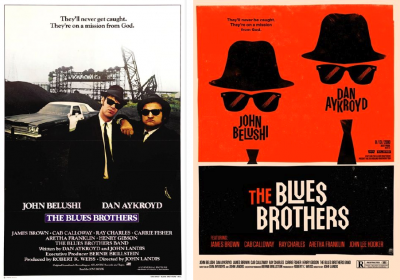 THE BLUES BROTHERS (1980) is the story of redemption for paroled convict Jake (John Belushi) and his brother Elwood (Dan Aykroyd), who take on a mission from God to save the orphanage in which they grew up. To do so they must reunite their band and organise a performance to earn $5,000 to pay the tax assessor. Along the way they are targeted by a destructive ‘mystery woman’ (Carrie Fisher), Neo-Nazis, and a country and western band – all the while being relentlessly pursued by the police. Boasting great blues music, big laughs and a range of rhythm-and-blues guest stars and cameos to die for, The Blues Brothers is also a fine big-screen showcase for the raucous gut-busting talents of cult legend John Belushi, and features musical numbers by James Brown, Cab Calloway, Aretha Franklin, Ray Charles and John Lee Hooker. Released in 1980, it received generally good reviews, and earned about US$5 million dollars in its opening weekend and went on to gross more than US$115 million in theatres worldwide before its release on home video.
THE BLUES BROTHERS (1980) is the story of redemption for paroled convict Jake (John Belushi) and his brother Elwood (Dan Aykroyd), who take on a mission from God to save the orphanage in which they grew up. To do so they must reunite their band and organise a performance to earn $5,000 to pay the tax assessor. Along the way they are targeted by a destructive ‘mystery woman’ (Carrie Fisher), Neo-Nazis, and a country and western band – all the while being relentlessly pursued by the police. Boasting great blues music, big laughs and a range of rhythm-and-blues guest stars and cameos to die for, The Blues Brothers is also a fine big-screen showcase for the raucous gut-busting talents of cult legend John Belushi, and features musical numbers by James Brown, Cab Calloway, Aretha Franklin, Ray Charles and John Lee Hooker. Released in 1980, it received generally good reviews, and earned about US$5 million dollars in its opening weekend and went on to gross more than US$115 million in theatres worldwide before its release on home video.
 BLUE VELVET (1986) centres on college student Jeffrey Beaumont (Kyle MacLachlan) who comes across a human ear in a field in his hometown of Lumberton. He proceeds to investigate the ear with help from high school student Sandy Williams (Laura Dern), who provides him with information and leads from her father, a local police detective. Jeffrey’s investigation draws him deeper into his hometown’s seedy underworld, and sees him forming a sexual relationship with alluring torch singer Dorothy Vallens (Isabella Rossellini), and uncovering criminal Frank Booth (Dennis Hopper) who indulges in drugs and sexual violence. This weird, surreal, genre-bending head-trip from auteur David Lynch spurred on a huge cult in the eighties, and served as the unofficial starting point for his television series Twin Peaks, which practically redefined television in the nineties.
BLUE VELVET (1986) centres on college student Jeffrey Beaumont (Kyle MacLachlan) who comes across a human ear in a field in his hometown of Lumberton. He proceeds to investigate the ear with help from high school student Sandy Williams (Laura Dern), who provides him with information and leads from her father, a local police detective. Jeffrey’s investigation draws him deeper into his hometown’s seedy underworld, and sees him forming a sexual relationship with alluring torch singer Dorothy Vallens (Isabella Rossellini), and uncovering criminal Frank Booth (Dennis Hopper) who indulges in drugs and sexual violence. This weird, surreal, genre-bending head-trip from auteur David Lynch spurred on a huge cult in the eighties, and served as the unofficial starting point for his television series Twin Peaks, which practically redefined television in the nineties.
Although initially detested by some critics, the film is now widely acclaimed and earned Lynch his second Oscar nomination for Best Director. As an example of a director casting against the norm, Blue Velvet is also noted for re-launching Dennis Hopper’s career and for providing Isabella Rossellini with a dramatic outlet beyond the work as a fashion model and a cosmetics spokeswoman for which she had until then been known. The screenplay of Blue Velvet had been passed around for a decade, with many major studios declining it because of its strong sexual and violent content. Since its initial theatrical release, Blue Velvet has achieved cult status, significant academic attention and is widely regarded as one of Lynch’s finest works, alongside Eraserhead (1976) and Mulholland Drive (2001). It is also seen by many critics as representing a modern-day version of film-noir aka neo-noir, present in many thrillers of the eighties and nineties.
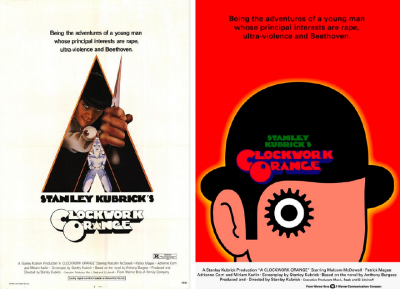 A CLOCKWORK ORANGE (1971) concerns Alex (Malcolm McDowell), a charismatic delinquent whose pleasures are classical music, rape, and so-called ultra-violence. He leads a small gang of thugs whom he calls his droogs (from the Russian друг, friend, buddy). The film tells the horrific crime spree of his gang, his capture, and attempted rehabilitation via a controversial psychological conditioning technique. Alex narrates most of the film in Nadsat, a fractured contemporary adolescent language comprising Slavic, English and Cockney rhyming slang. When it comes to cult, Stanley Kubrick cannot be denied, and this is the wild card in his deck. A violent, typically dystopian nightmare that questions the very foundations of society itself. A Clockwork Orange is a darkly satirical science fiction film adaptation of the Anthony Burgess novel of the same name. It features disturbing, violent images to facilitate social commentary about psychiatry, youth gangs and other contemporary social, political and economic subjects in a dystopian future Britain. A Clockwork Orange features a soundtrack comprising mostly classical music selections and Moog synthesiser compositions by Walter/Wendy Carlos, although a notable exception is Singin’ In The Rain, chosen because it was a song that actor Malcolm McDowell knew well. The film also holds the Guinness World Record for being the first film in media history to use the Dolby Sound system.
A CLOCKWORK ORANGE (1971) concerns Alex (Malcolm McDowell), a charismatic delinquent whose pleasures are classical music, rape, and so-called ultra-violence. He leads a small gang of thugs whom he calls his droogs (from the Russian друг, friend, buddy). The film tells the horrific crime spree of his gang, his capture, and attempted rehabilitation via a controversial psychological conditioning technique. Alex narrates most of the film in Nadsat, a fractured contemporary adolescent language comprising Slavic, English and Cockney rhyming slang. When it comes to cult, Stanley Kubrick cannot be denied, and this is the wild card in his deck. A violent, typically dystopian nightmare that questions the very foundations of society itself. A Clockwork Orange is a darkly satirical science fiction film adaptation of the Anthony Burgess novel of the same name. It features disturbing, violent images to facilitate social commentary about psychiatry, youth gangs and other contemporary social, political and economic subjects in a dystopian future Britain. A Clockwork Orange features a soundtrack comprising mostly classical music selections and Moog synthesiser compositions by Walter/Wendy Carlos, although a notable exception is Singin’ In The Rain, chosen because it was a song that actor Malcolm McDowell knew well. The film also holds the Guinness World Record for being the first film in media history to use the Dolby Sound system.
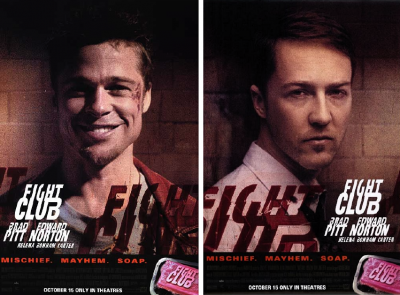 FIGHT CLUB (1999) stars Edward Norton as the unnamed protagonist, an ‘Everyman’ who becomes discontented with his white-collar job in American society. He forms a Fight Club with soap salesman Tyler Durden (Brad Pitt) and becomes embroiled in a relationship with him and a dissolute woman, Marla Singer (Helena Bonham Carter). David Fincher‘s big, black, nasty vision of consumerist America appealed to the misanthrope in everyone, and Fight Club’s imagery of compromised machismo have created a strong cult following among young guys looking for answers.
FIGHT CLUB (1999) stars Edward Norton as the unnamed protagonist, an ‘Everyman’ who becomes discontented with his white-collar job in American society. He forms a Fight Club with soap salesman Tyler Durden (Brad Pitt) and becomes embroiled in a relationship with him and a dissolute woman, Marla Singer (Helena Bonham Carter). David Fincher‘s big, black, nasty vision of consumerist America appealed to the misanthrope in everyone, and Fight Club’s imagery of compromised machismo have created a strong cult following among young guys looking for answers.
Fincher was one of four directors the producers considered – they hired him because of his enthusiasm for the film. Fincher intended Fight Club’s violence to serve as a metaphor for the conflict between a generation of young people and the value system of advertising. The director copied the homo-erotic overtones from the original novel to make audiences uncomfortable and keep them from anticipating the twist ending. Fight Club failed to meet the studio’s expectations at the box office, received polarised reactions from critics, and was cited as one of the most controversial and talked-about films of the year. Some actually saw it as an omen for change in American political life, and described its visual style as ground-breaking. The film later found commercial success with its DVD release, which established Fight Club as a cult film.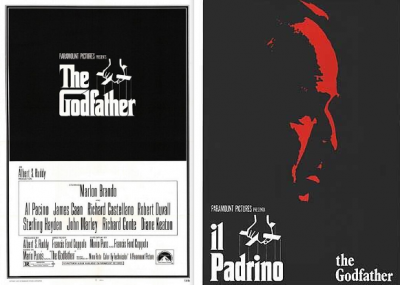
THE GODFATHER (1972) begins as Don Vito Corleone (Marlon Brando), the head of a New York Mafia family, oversees his daughter’s wedding. His beloved son Michael has just come home from the war, but does not intend to become part of his father’s business. Through Michael’s life the nature of the family business becomes clear. The business of the family is just like the head of the family, kind and benevolent to those who give respect, but given to ruthless violence whenever anything stands against the good of the family. Don Vito lives his life in the way of the old country, but times are changing and some don’t want to follow the old ways and look out for community and family.
An up-and-coming rival of the Corleone family wants to start selling drugs in New York, and needs the Don’s influence to further his plan. The clash of the Don’s fading old world values and the new ways will demand a terrible price, especially from Michael, all for the sake of the family. With a grand operatic flourish, Francis Ford Coppola lifted the lid on the Mafia, and nothing has ever been the same since. The Mafia cult starts here. The story spans ten years from 1945 to 1955 and chronicles the fictional Italian-American Corleone crime family. Two sequels followed: The Godfather Part II (1974) and The Godfather Part III (1990). The Godfather received Oscars for Best Picture, Best Actor and Best Adapted Screenplay, and has been selected for preservation in the United States National Film Registry. Furthermore, it ranked third on the American Film Institute’s 100 Years 100 Movies list, behind Citizen Kane (1941) and Casablanca (1942).
MAD MAX (1979) is set in the post-apocalyptic Australian state of Victoria where all manner of scum proliferate on the highway while a diminished, leather-clad police force attempt to keep the peace in their suped-up Ford Interceptors. When a fire-and-brimstone terminal loony named The Nightrider gets his comeuppance from top pursuit cop Max Rockatansky (Mel Gibson), his biker devotees – led by the soft-spoken psycho The Toecutter (Hugh Keays-Byrne) – get even by threatening Max’s wife (Joanne Samuel) and child (amusingly nick-named Sprog) with predictably tragic consequences. “You’re a winner, Max!” This Australian action masterpiece from George Miller spoke to cultures all over the world, and Max’s V-8 sent him tearing into cult history. Its narrative based around the traditional western genre, Mad Max tells a story of the breakdown of society, murder and vengeance. It became a top-grossing Australian film and has been credited for further opening up the global market to Australian New Wave films. The film was also notable for being the first Australian film to be shot with a widescreen anamorphic lens, and has had a lasting influence on post-apocalyptic fiction. The first in the franchise, Mad Max spawned sequels Mad Max II The Road Warrior (1981) and Mad Max III Beyond Thunderdome (1985). The fourth film in the series, tentatively titled Mad Max IV Fury Road, is currently in production.
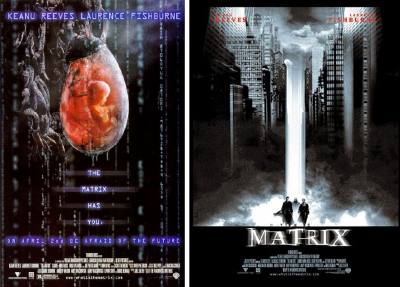 THE MATRIX (1999) depicts a future in which reality as perceived by most humans is actually a simulated reality created by sentient machines to pacify and subdue the human population, while their bodies heat and electrical activity are used as an energy source. Upon learning this, computer programmer Neo (Keanu Reeves) is drawn into a rebellion against the machines, involving other people who have been freed from the dream world and into reality. A slick high-style science fiction blast from the Wachowski Brothers that bent the genre all over the place and introduced cyberspace to the mainstream, and besides, has Keanu ever been this cool? It’s the first installment in the Matrix series of films, comics, games and animation. The film contains many references to the cyberpunk and hacker subcultures, philosophical and religious ideas, and homages to Alice In Wonderland, Kung Fu films, spaghetti westerns, dystopian fiction and Anime.
THE MATRIX (1999) depicts a future in which reality as perceived by most humans is actually a simulated reality created by sentient machines to pacify and subdue the human population, while their bodies heat and electrical activity are used as an energy source. Upon learning this, computer programmer Neo (Keanu Reeves) is drawn into a rebellion against the machines, involving other people who have been freed from the dream world and into reality. A slick high-style science fiction blast from the Wachowski Brothers that bent the genre all over the place and introduced cyberspace to the mainstream, and besides, has Keanu ever been this cool? It’s the first installment in the Matrix series of films, comics, games and animation. The film contains many references to the cyberpunk and hacker subcultures, philosophical and religious ideas, and homages to Alice In Wonderland, Kung Fu films, spaghetti westerns, dystopian fiction and Anime.
PSYCHO (1960) depicts the frightening encounter between secretary Marion Crane (Janet Leigh), who is in hiding at a motel after embezzling from her employer, and motel owner Norman Bates (Anthony Perkins), and the aftermath of their encounter. Master of suspense Alfred Hitchcock is a cult unto himself, and Psycho is the big daddy when it comes to his particular brand of kinky sadistic thrills. The film is based on the screenplay by Joseph Stefano who adapted it from the 1959 novel by Robert Bloch. The novel was inspired by the crimes of Wisconsin serial killer Ed Gein, whose story is more faithfully told in the excellent independent film Deranged (1974). Psycho initially received mixed reviews, but outstanding box office returns prompted new reviews which were overwhelmingly positive and led to four Oscar nominations. Psycho is now considered one of Hitchcock’s best films and is highly praised as a work of cinematic art by international critics. The film has also spawned three sequels, a television spin-off (starring the wonderful Bud Cort), and an extremely faithful scene-for-scene word-for-word remake (a first in itself) directed by Gus Van Sant.
PULP FICTION (1994) is directed in a highly stylised manner, joining the intersecting story-lines of Los Angeles mobsters, fringe players, small-time criminals, and a mysterious briefcase. Considerable screen time is devoted to conversations and monologues that reveal the characters humour and perspectives on life. The plot, in keeping with most of Quentin Tarantino‘s other works, is presented out of chronological sequence. Pulp Fiction turned movie-making on its head in the mid-nineties and made writer-director Tarantino a superstar, famed for his black humour and pungent dialogue. The film was nominated for seven Oscars including Best Picture, and winning for Best Original Screenplay. It was also awarded the Palme d’Or at the 1994 Cannes Film Festival. A major critical and commercial success, it revitalised the career of leading man John Travolta who received an Oscar nomination, as did co-stars Samuel L. Jackson and Uma Thurman. The film’s unconventional structure and extensive use of homage and pastiche have led critics to describe it as a prime example of postmodern film. Considered by some to be a black comedy, the film is also frequently labeled as neo-noir, and is viewed as the inspiration for many later movies that adopted various elements of its style. The nature of its development, marketing, and distribution and its consequent profitability had a sweeping effect on the field of independent cinema (although it’s not an independent film itself). A cultural watershed, Pulp Fiction’s influence has been felt worldwide.
REQUIEM FOR A DREAM (2000) focuses on Sarah Goldfarb (Ellen Burstyn), an aging Brooklyn widow who worries about her wayward son Harry (Jared Leto) and looks to her television for company. When she’s approached to apply to be a game show contestant her life begins to unravel even further. Fueled by her desire to look good for the camera, she starts dieting, aided by a dodgy back-street quack with a profitable sideline in pushing appetite suppressants. Within a few months she’s hooked – uppers for lunch, downers for dinner, food is the devil and the fridge is its lair. Harry quickly recognises his mother’s predicament, not least because he’s a heroine fiend himself. He lives a precarious existence with his drug cohorts, his girlfriend Marion (Jennifer Connelly) and Tyrone (Marlon Wayans). They’re more clued-in to the perils of addiction than Sarah but, sadly, no better at escaping its grip. From Spring to the following Winter, the four follow a predictable desperate path: Scoring, stealing and self-delusion – four season in one hell. As Sarah loses her mind, Harry quite literally rots his body and Marion slips into prostitution, providing few redemptive outlets for the viewer. This is deliberate, as is the fact that the colour red is only really seen in Sarah’s hair and red dress. Based on the novel by Hubert Selby Junior, the creator of Last Exit To Brooklyn (1989), Requiem For A Dream immerses us in the cracked psyches of a group of friends, lovers and relatives divided by their various addictions, whether it be drugs, television, chocolate, dieting, or popular culture. Hard-hitting and confrontational, it is obviously Darren Aranofsky‘s attempt to cinematically capture the impact felt when one first reads the book.
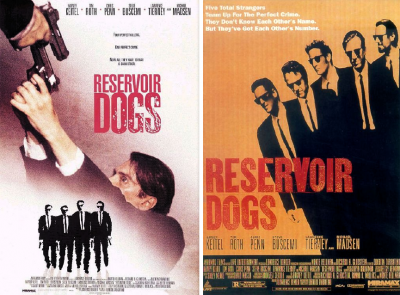 RESERVOIR DOGS (1992) depicts the events before and after a botched diamond heist, but not the actual heist itself. Reservoir Dogs stars an ensemble cast with Harvey Keitel, Steve Buschemi, Tim Roth, Michael Madsen, Chris Penn and Lawrence Tierney. Quentin Tarantino has a minor role, as does criminal-turned-author Eddie Bunker. It incorporates many themes and aesthetics that have become Tarantino’s hallmarks: violent crime, pop culture, memorable dialogue, profuse profanity and a nonlinear story-line. The dazzlingly ferocious cult phenomenon that put Tarantino on the map before he went supernova and picked up an Oscar for Pulp Fiction (1994). The film has become a classic of independent cinema and a cult hit. Reservoir Dogs was generally well received and the cast was praised by many critics and, although it was never given much promotion upon release, the film was a modest success by making its US$1.2 million budget back. It became a major hit in Britain, however, grossing 6.5 million pounds, and achieved higher popularity after the success of Tarantino’s Pulp Fiction. It is often criticised for its high degree of violence and profanity, and some preview audience members reportedly walked out during the film’s now notorious torture scene.
RESERVOIR DOGS (1992) depicts the events before and after a botched diamond heist, but not the actual heist itself. Reservoir Dogs stars an ensemble cast with Harvey Keitel, Steve Buschemi, Tim Roth, Michael Madsen, Chris Penn and Lawrence Tierney. Quentin Tarantino has a minor role, as does criminal-turned-author Eddie Bunker. It incorporates many themes and aesthetics that have become Tarantino’s hallmarks: violent crime, pop culture, memorable dialogue, profuse profanity and a nonlinear story-line. The dazzlingly ferocious cult phenomenon that put Tarantino on the map before he went supernova and picked up an Oscar for Pulp Fiction (1994). The film has become a classic of independent cinema and a cult hit. Reservoir Dogs was generally well received and the cast was praised by many critics and, although it was never given much promotion upon release, the film was a modest success by making its US$1.2 million budget back. It became a major hit in Britain, however, grossing 6.5 million pounds, and achieved higher popularity after the success of Tarantino’s Pulp Fiction. It is often criticised for its high degree of violence and profanity, and some preview audience members reportedly walked out during the film’s now notorious torture scene.
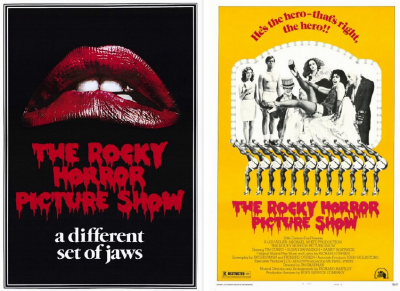 THE ROCKY HORROR PICTURE SHOW (1975) is so much more than just a musical parody of B-grade science fiction and horror films. Director Jim Sharman collaborated on the screenplay with Richard O’Brien, who wrote both the book and lyrics for the stage. The film introduces Tim Curry and features Susan Sarandon and Barry Bostwick along with cast members from the original 1973 stage production. “Let’s do the Time Warp again!” Thirty-five years later The Rocky Horror Picture Show still has mad cultists dancing in the aisles, dressing up and shouting call-back lines. The sign of a true cult film is one that literally spills off the screen and into people’s lives, and with its dress-up sing-along appeal, The Rocky Horror Picture Show is the ultimate cult movie. Still in limited release thirty-five years after its premiere, it has the longest-running theatrical release in film history.
THE ROCKY HORROR PICTURE SHOW (1975) is so much more than just a musical parody of B-grade science fiction and horror films. Director Jim Sharman collaborated on the screenplay with Richard O’Brien, who wrote both the book and lyrics for the stage. The film introduces Tim Curry and features Susan Sarandon and Barry Bostwick along with cast members from the original 1973 stage production. “Let’s do the Time Warp again!” Thirty-five years later The Rocky Horror Picture Show still has mad cultists dancing in the aisles, dressing up and shouting call-back lines. The sign of a true cult film is one that literally spills off the screen and into people’s lives, and with its dress-up sing-along appeal, The Rocky Horror Picture Show is the ultimate cult movie. Still in limited release thirty-five years after its premiere, it has the longest-running theatrical release in film history.
It gained notoriety as a midnight movie in 1977-1978 when audiences began participating with the film in theatres. Rocky Horror is the first film from a major Hollywood studio to be in the midnight movie market. The motion picture has a large international following and is one of the most well-known and financially successful midnight movies of all time. Rocky Horror, a film which attempts to break every Hollywood taboo possible (including cannibalism, homosexuality, lesbianism, incest, sado-masochism, transvestism, bad table manners, etc.) was selected in 2005 for preservation in the United States National Film Registry by the Library Of Congress as being culturally, historically or aesthetically significant.
SCARFACE (1983) is loosely based on Howard Hawks original 1932 film, and tells the story of a fictional Cuban refugee named Tony Montana who arrives in Miami in 1980, and becomes a gangster against the backdrop of the eighties cocaine boom. The film chronicles his rise to the top of Miami’s criminal underworld and subsequent downfall in tragic Greek fashion. “Say hello to my little friend!” Al Pacino‘s vicious drug-dealer Montana has been an icon for gangsters all over the world, which may not be the kind of cult that director Brian DePalma or writer Oliver Stone was expecting. The film is dedicated to Howard Hawks and Ben Hecht, who were the director and screenwriter respectively of the original 1932 film. The initial critical response to Scarface was mixed, with the film receiving criticism for its violence and graphic language. Nevertheless (or perhaps because of this), the film has since gathered a cult following and has become an important cultural icon inspiring posters, clothing and many other references. The film’s grainy black and white poster is a popular decoration and is still in print, and as a result of its popularity it has been parodied many times.
SE7EN (1995) introduces us to police detectives David Mills (Brad Pitt) and William Somerset (Morgan Freeman) working in a crime-filled city who become deeply involved in a case involving a series of sadistic murders. The murders are all in correspondence to each of the seven deadly sins: Gluttony, Envy, Lust, Pride, Sloth, Greed and Wrath. Here comes Gwyneth’s head in a box! Just when you thought the serial killer film couldn’t go any further, director David Fincher proved that he could bring the pain like no other. Fincher approached making Se7en like a tiny genre movie, the kind of movie William Friedkin might have made after making The Exorcist (1973). He worked with cinematographer Darius Khondji and adopted a simple approach to the camerawork, which was influenced by the television show Cops and how the camera is always in the backseat or peering over shoulders. The urban streets are filled with crowded, noisy denizens and an oppressive rain that always seems to fall without respite was an integral part of the film, as Fincher wanted to show a city that was dirty, violent, polluted and depressing. Visually and stylistically, that’s how he wanted to portray this world. To this end, Fincher turned to production designer Arthur Max to create a dismal world that often eerily mirrors its inhabitants. Grossing US$327 million at the box office internationally, Se7en was a commercial success, and received very positive reviews from most critics.
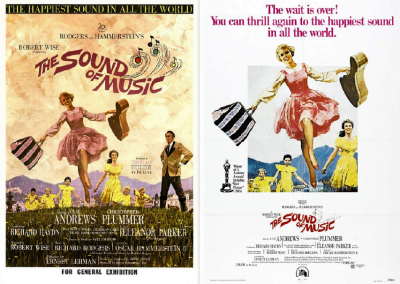 THE SOUND OF MUSIC (1965) is based on The Story Of The Trapp Family Singers by Maria Von Trapp. Many songs from the musical have become standards, including Edelweiss, My Favourite Things, Climb Every Mountain and Do-Re-Mi. The original Broadway production starring Mary Martin and Theodore Bikel opened in November 1959, and the show has enjoyed numerous productions and revivals since then, including the Oscar-winning 1965 movie musical starring Julie Andrews. The hills are alive, and so is the cult for this film. Not just a television favourite, The Sound Of Music has even inspired its own ‘sing-along’ theatre version, with subtitles for those few who don’t already know the words. Besides, where else are you going to find a G-rated film with Nuns, Nazis, goats and children? And that song in which the Nuns sing “You can’t! You can’t! You can’t!” always sounds like they’re saying something else very un-Nun-like indeed. Speaking of which, The Sound of Music was the final musical written by Rodgers & Hammerstein, as Mr. Hammerstein sadly passed away of cancer nine months after the Broadway premiere. The film sports a fascinating selection of future genre talent including Christopher Plummer, who tried to kill William Shatner (and who could blame him?) in Star Trek VI The Undiscovered Country (1991) and has since become a member of Tim Burton’s growing ensemble. Future television actors include Angela Cartwright of Lost In Space, Heather Menzies of Logan’s Run, Nicholas Hammond of Spider-Man, and the – ahem – cherry on top is Julie Andrews who, in recent times, seems to take great pleasure in sending-up the wholesome image she created in the sixties.
THE SOUND OF MUSIC (1965) is based on The Story Of The Trapp Family Singers by Maria Von Trapp. Many songs from the musical have become standards, including Edelweiss, My Favourite Things, Climb Every Mountain and Do-Re-Mi. The original Broadway production starring Mary Martin and Theodore Bikel opened in November 1959, and the show has enjoyed numerous productions and revivals since then, including the Oscar-winning 1965 movie musical starring Julie Andrews. The hills are alive, and so is the cult for this film. Not just a television favourite, The Sound Of Music has even inspired its own ‘sing-along’ theatre version, with subtitles for those few who don’t already know the words. Besides, where else are you going to find a G-rated film with Nuns, Nazis, goats and children? And that song in which the Nuns sing “You can’t! You can’t! You can’t!” always sounds like they’re saying something else very un-Nun-like indeed. Speaking of which, The Sound of Music was the final musical written by Rodgers & Hammerstein, as Mr. Hammerstein sadly passed away of cancer nine months after the Broadway premiere. The film sports a fascinating selection of future genre talent including Christopher Plummer, who tried to kill William Shatner (and who could blame him?) in Star Trek VI The Undiscovered Country (1991) and has since become a member of Tim Burton’s growing ensemble. Future television actors include Angela Cartwright of Lost In Space, Heather Menzies of Logan’s Run, Nicholas Hammond of Spider-Man, and the – ahem – cherry on top is Julie Andrews who, in recent times, seems to take great pleasure in sending-up the wholesome image she created in the sixties.
STAR WARS IV: A NEW HOPE (1977) is set a long time ago in a galaxy far away and follows a group of freedom fighters known as the Rebel Alliance as they plot to destroy the powerful Death Star, a devastating weapon created by the evil Galactic Empire. This conflict disrupts the isolated life of farm-boy Luke Skywalker (Mark Hamill) when he inadvertently acquires the droids carrying the stolen plans to the Death Star. After the Empire begins a cruel and destructive search for the droids, Skywalker decides to accompany ex-Jedi Knight Obi-Wan Kenobi (Alec Guinness) on a daring mission to rescue the owner of the droids, rebel leader Princess Leia Organa (Carrie Fisher), and save the galaxy. From the mountains of merchandise to the obsessive fans and cultists who know every film in the series off by heart, Star Wars is the sort of film that some would fall on their sword for.
Later retitled Star Wars IV: A New Hope, it is the first of six films released in the Star Wars saga: Two subsequent films complete the original trilogy, while a prequel trilogy completes the six-part saga. Ground-breaking in its use of special effects, unconventional editing, and science fiction/fantasy storytelling, the original Star Wars is one of the most successful and influential films of all time. Produced on a budget of US$11 million and released in 1977, the film went on to earn US$460 million in the United States and another US$337 million overseas, surpassing Jaws (1975) as the highest-grossing film of all-time. Among the many awards the film received, it gained ten Oscar nominations, winning seven. Nominations included Best Picture and Best Supporting Actor for Alec Guinness. George Lucas has re-released the film on several occasions, sometimes with significant changes, the most notable versions are the 1997 Special Edition and the 2004 DVD release, which have modified computer generated effects, altered dialogue and added scenes.
TAXI DRIVER (1976) is set in New York City soon after the Vietnam War, and boasts a legendary cast of superlative professionals including Robert DeNiro, Peter Boyle, Albert Brooks, Jodie Foster, Harvey Keitel, and Cybill Shepherd. Nominated for four Oscars, winner of none, Taxi Driver was vindicated by being awarded the Palme d’Or at the 1976 Cannes Film Festival. Robert DeNiro’s Travis Bickle is the ultimate seventies loner, an alienated taxi driver hooked on p*rn, guns, assassination and the smell of the streets. In other words, a cult hero waiting to happen. Directed by Martin Scorsese and written by Paul Schrader, the film’s best moments are not the violent ones, as much as the surreal rides DeNiro takes us in his taxi. These haunting rides establish that Travis is out-of-sync with the world around him, and are beautifully shot mood pieces. No director has better captured the peculiarly wretch look and feel of the underbelly of New York, ably assisted by Michael Chapman’s cinematography and a haunting jazz score by maestro Bernard Herrmann, who sadly passed away the very day he completed the score for Taxi Driver. Already controversial upon its release, the film hit the headlines again five years later in 1981, when John Hinckley Junior made an assassination attempt on then-President Ronald Reagan. He subsequently blamed his act on his obsession with Iris Steensman, the character portrayed by Jodie Foster. This event was so influential that paranoid television executives demanded that The Greatest American Hero change his surname from Hinkley to Hanley, but that’s another story for another time.
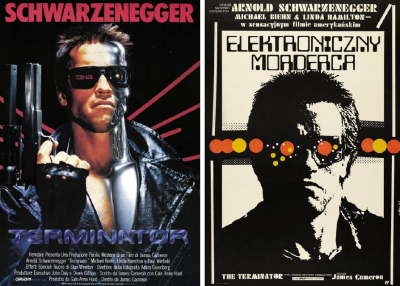 THE TERMINATOR (1984) is played with relish by Arnold Schwarzenegger, a cyborg assassin sent back in time from the year 2029 to 1984 to kill Sarah Connor (Linda Hamilton). Kyle Reese (Michael Biehn) is a soldier from the future sent back in time to protect Sarah. The cult of Schwarzenegger was born with James Cameron‘s bloody, extraordinarily imaginative science fiction slammer, and a new franchise was born. Though not expected to be either a commercial or critical success, The Terminator topped the American box office for two weeks and helped launch the film careers of Cameron, Schwarzenegger and just about everyone else involved with the making of the film. It received mixed reviews from critics upon its release, but later critical opinion of the film was more positive. In 2008 it was selected by the Library Of Congress for preservation in the United States National Film Registry, being deemed culturally, historically, or aesthetically significant. The history of the story is a convoluted one involving Mr. Cameron’s dream of The Terminator and author Harlan Ellison‘s short story Soldier, adapted as an old Outer Limits episode. A very good science fiction story indeed, but you’ll find little similarity between Soldier and The Terminator. In my humble (yet always accurate) opinion, to find the real source of The Terminator you must seek out a film entitled Cyborg 2087 (1966) starring Michael Rennie as Garth, a cyborg from the future who travels back in time to 1966 to prevent a scientist from revealing his new discovery which will make mind control possible and create tyranny in Garth’s time. Garth is also being pursued by two cyborgs known as Tracers out to stop him. Sound familiar?
THE TERMINATOR (1984) is played with relish by Arnold Schwarzenegger, a cyborg assassin sent back in time from the year 2029 to 1984 to kill Sarah Connor (Linda Hamilton). Kyle Reese (Michael Biehn) is a soldier from the future sent back in time to protect Sarah. The cult of Schwarzenegger was born with James Cameron‘s bloody, extraordinarily imaginative science fiction slammer, and a new franchise was born. Though not expected to be either a commercial or critical success, The Terminator topped the American box office for two weeks and helped launch the film careers of Cameron, Schwarzenegger and just about everyone else involved with the making of the film. It received mixed reviews from critics upon its release, but later critical opinion of the film was more positive. In 2008 it was selected by the Library Of Congress for preservation in the United States National Film Registry, being deemed culturally, historically, or aesthetically significant. The history of the story is a convoluted one involving Mr. Cameron’s dream of The Terminator and author Harlan Ellison‘s short story Soldier, adapted as an old Outer Limits episode. A very good science fiction story indeed, but you’ll find little similarity between Soldier and The Terminator. In my humble (yet always accurate) opinion, to find the real source of The Terminator you must seek out a film entitled Cyborg 2087 (1966) starring Michael Rennie as Garth, a cyborg from the future who travels back in time to 1966 to prevent a scientist from revealing his new discovery which will make mind control possible and create tyranny in Garth’s time. Garth is also being pursued by two cyborgs known as Tracers out to stop him. Sound familiar?
 THE USUAL SUSPECTS (1995) follows the interrogation of Roger Kint (Kevin Spacey), a small-time con-man who is one of only two survivors of a massacre and fire on a ship docked at the Port of Los Angeles. He tells an interrogator a convoluted story about events that lead him and four other criminals to the boat, and of a mysterious mob boss known as Keyser Söze who commissioned their work. Using both flashbacks and narration, Kint’s story becomes increasingly complex. Sometimes crime does pay, and this smart, stylish heist flick from director Bryan Singer kept audiences on their toes on its cinema release, and has kept them renting it ever since to unravel its tricky puzzles. The neo-noir film boasts an amazing cast of character actors including Stephen Baldwin, Gabriel Byrne, Benicio Del Toro, Chazz Palminteri, and Kevin Pollack. Shot on a US$6 million budget, The Usual Suspects originally began as a title taken from a column in Spy magazine after one of Claude Rains’ most memorable lines in Casablanca (1942). Singer thought that it would be a good title for a film, the poster for which he had developed as the first visual idea. The Usual Suspects was shown out of competition at the 1995 Cannes Film Festival and then initially released in few theatres. It received good reviews, and was eventually given a wider release, gaining Oscars for Best Original Screenplay and Best Supporting Actor for Kevin Spacey.
THE USUAL SUSPECTS (1995) follows the interrogation of Roger Kint (Kevin Spacey), a small-time con-man who is one of only two survivors of a massacre and fire on a ship docked at the Port of Los Angeles. He tells an interrogator a convoluted story about events that lead him and four other criminals to the boat, and of a mysterious mob boss known as Keyser Söze who commissioned their work. Using both flashbacks and narration, Kint’s story becomes increasingly complex. Sometimes crime does pay, and this smart, stylish heist flick from director Bryan Singer kept audiences on their toes on its cinema release, and has kept them renting it ever since to unravel its tricky puzzles. The neo-noir film boasts an amazing cast of character actors including Stephen Baldwin, Gabriel Byrne, Benicio Del Toro, Chazz Palminteri, and Kevin Pollack. Shot on a US$6 million budget, The Usual Suspects originally began as a title taken from a column in Spy magazine after one of Claude Rains’ most memorable lines in Casablanca (1942). Singer thought that it would be a good title for a film, the poster for which he had developed as the first visual idea. The Usual Suspects was shown out of competition at the 1995 Cannes Film Festival and then initially released in few theatres. It received good reviews, and was eventually given a wider release, gaining Oscars for Best Original Screenplay and Best Supporting Actor for Kevin Spacey.
 Horror News | HNN Official Site | Horror Movies,Trailers, Reviews
Horror News | HNN Official Site | Horror Movies,Trailers, Reviews
